It was an armed wing of the Polish Underground State, an umbrella organization for all resistance movements in Poland during the war. Home Army used partisan and urban guerrilla warfare to fight the occupation with sabotage and small scale skirmishes with German forces in the countryside. At the height of its power, in 1944, it was estimated that the Home Army had more than 400,000 members, but many of them weren’t properly armed.
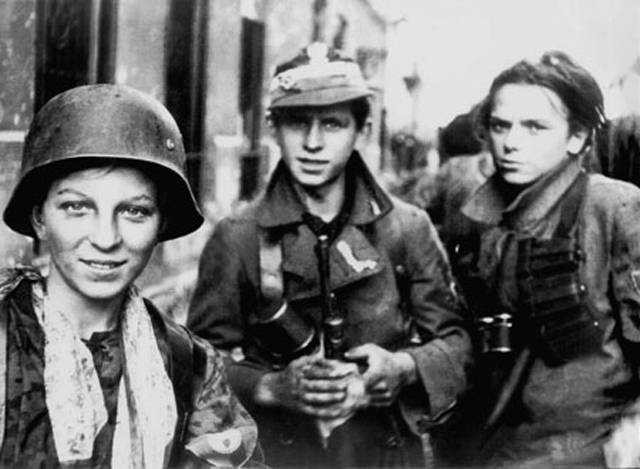

1. Blyskawica Submachine Gun
Blyskawica was the backbone of the Polish underground weapons industry. Along with the Polish version of the Sten submachine gun, originally produced in Britain, the Blyskawica was the only weapon covertly manufactured in mass numbers during WWII. It was designed by two Polish engineers, Wacław Zawrotny and Seweryn Wielanier, and it combined the exterior of a German MP-40 sub-machine gun and the interior mechanism of the English Sten. All parts of the weapon were joined together with screws and threads, rather than bolts and welding.This allowed easier production for less capable engineers since it used a system dating back to the 17th century. The similarity with the German sub-machine gun enabled the use of captured ammunition, as it used the same caliber and the magazine was identical. It fitted the needs of the Home Army high command since it was easy to construct and it could be made out of different improvised materials that were available. In 1943, after series of tests, the Blyskawica was adopted as the official weapon of the Home Army.
The name, which in Polish means “Lightning”, came from the three lightning bolts that were carved on the prototypes by the workers who, before the war, owned the Electric company with the same logo. The production started in a workshop officially producing metal fence nets in Warsaw. The High command ordered 1,000 pieces, but only 600 were produced before the Warsaw uprising.
During the rebellion, 40 more were introduced into battle. The gun was produced in small quantities outside of Warsaw, but the majority of the production was happening in the city. After the failed insurrection the Home Army ordered another 300, but by that time, the Soviets were already advancing through Poland and the Germans were pushed back.
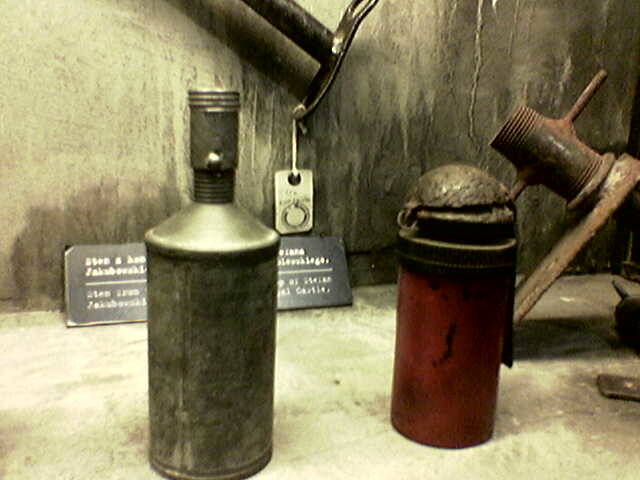
2. Filipinka and Sidolowka Hand Grenade
Filipinka, also known as Wanka and Perelka, was an unofficial name for ET wz. 40 hand grenade, manufactured in the Home Army underground facilities in 1940. It was designed by a former worker of the Rembertow Polish Army ammunition factory and based on a pre-war anti-tank grenade, model ET wz. 38. The designer was Edward Tymoszak, hence the ET abbreviation.The Filipinka was cylindrical in shape and used a fuse located on the upper part of the shell. It was an offensive impact grenade, which means it exploded when hitting the target. Roughly 4,000 were produced in the first series alone. First, they were made out of Bakelite, which shattered after explosion without producing fragments like a metal bodied grenade.
Later, Tymoszak introduced a shell with a metal impress. Filipinka used a variety of home-made explosives. Sometimes the engineers extracted the explosives from German air bombs and artillery shell and sometimes they used plastic explosive delivered via air bridges by the British RAF.
The improved version of the Filipinka hand grenade had an improved version manufactured in 1942, ET wz.42, commonly called Sidolowka. It was named after Sidol, a metal-cleaning agent from Henkel, packed in bottles suitable for grenade use. Besides from being an easily-available improvised shell, it was also a good camouflage, for the grenade resembled the Sidol pack. It was first produced in Warsaw by the professors of the Warsaw University of Technology, under the guidance of a chemist, called Jan Czochralski. The primer and the detonator were designed by pre-war experts from the Polish ammunition factory in Warsaw.
SHARES
| FacebookTwitter |
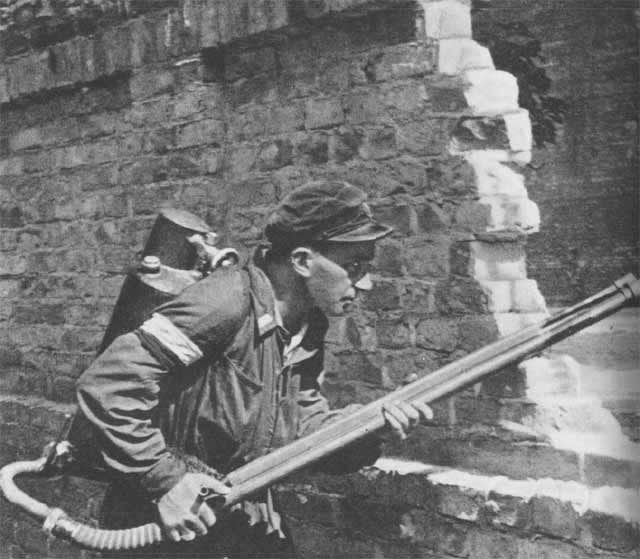
3. K-Pattern Flamethrower
A flamethrower is a vicious and effective weapon, which functions very well in urban areas, as a tool for eliminating enemies using buildings for cover. The Home Army saw the potential of an improvised flamethrower to catch the advantage against a better equipped and a better-trained enemy. The production started in 1942, but the weapon wasn’t used until the uprising in 1944 since the rebels didn’t want to reveal their ingenuity in improvised weapons.It’s the main purpose was to serve as an anti-tank weapon, inducing high temperature on the vehicle. It was suitable for production in workshops and used readily available materials.
It consisted of two tanks, one for fuel, the other for compressed air. The mixture was 75% diesel fuel, 25% gasoline. A metal pipe was attached to the canisters with a rubber gasoline hose. After pulling opening the handle on the pipe, the fuel mixed with compressed air was ignited by a simple cloth drenched in gasoline, on fire.
4. Kubus, the Armored Car
Kubus, a Polish nickname derived from Jacob, was a once-produced armored car by the Polish Home Army, used in the early stages of the Warsaw uprising. It was built on a chassis of a Chevrolet 157 truck and it took part in the Warsaw battles. It was originally produced within 13 days and handed out to fighters without previous testing. The designer of the vehicle was an engineer, Walerian Bielecki, nom de guerre Jan, who constructed the chassis without previous plans on paper and installed it on site.It was called after a partisan woman, codenamed Kubus, who was the wife of one of the engineers, codenamed Globius. Since she died a few days prior to the construction, the name was given as an honoring act. An interesting fact – Kubus is also the Polish name for the famous book and cartoon character, Winnie the Pooh.
The chassis was mounted on the base with steel plates for protection of the crew. The car could carry between 8 and 12 soldiers. It was armed with a Soviet DP machine gun and a K pattern flamethrower. Kubus took part in an attempt to capture the Warsaw University Campus, which was turned into a German stronghold. The attempt failed twice, Kubus was lightly damaged and the insurgents retreated to a Home Army held area. It was abandoned on September 6th, 1944.
The damaged Kubuś survived the war and in 1945 was towed to the Polish Army Museum as one of the first exhibits after it was looted by the Germans. It was restored and is currently on exhibition there. A full-scale operational replica was created in 2004 and is, as of 2009, on exhibition at the Warsaw Uprising Museum.

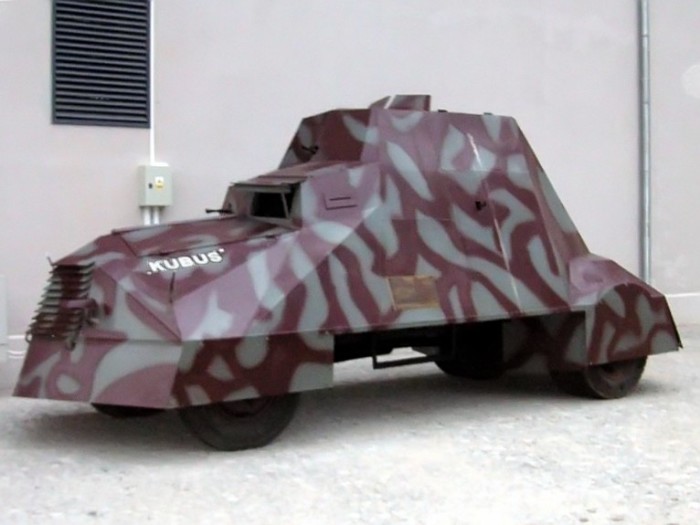
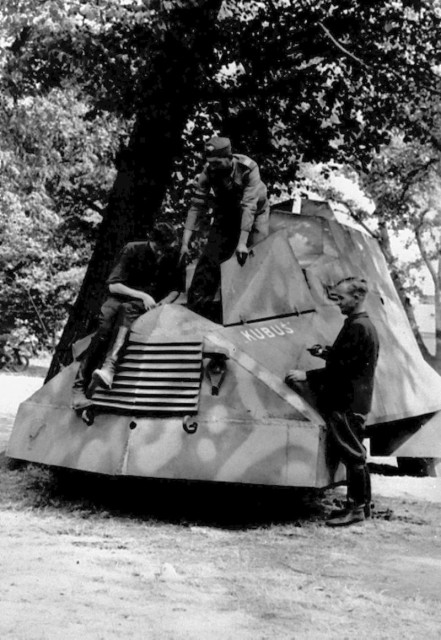
Δεν υπάρχουν σχόλια:
Δημοσίευση σχολίου